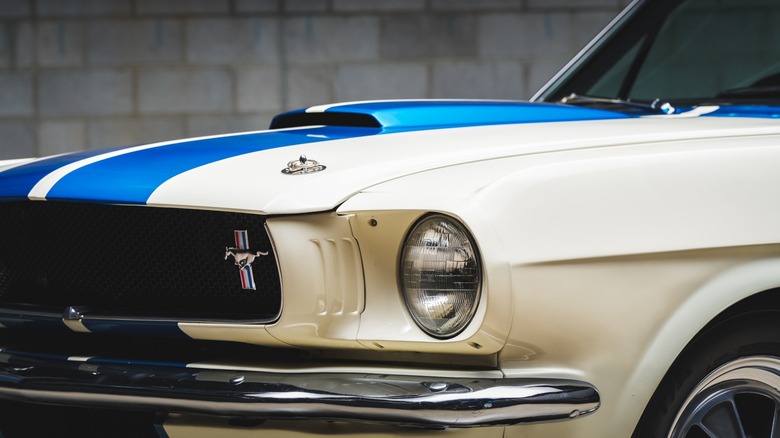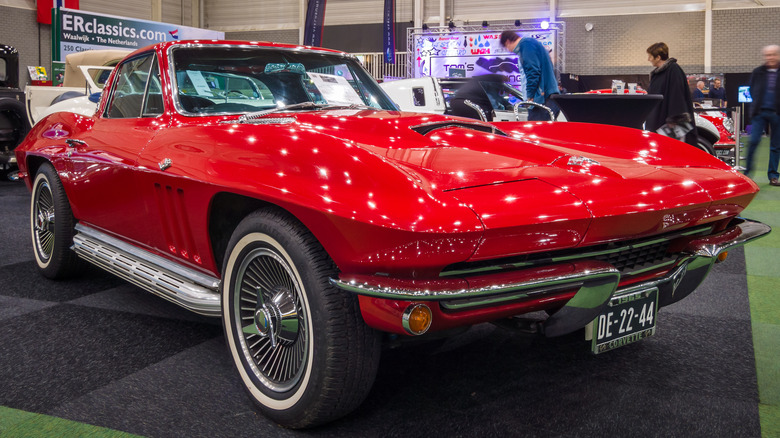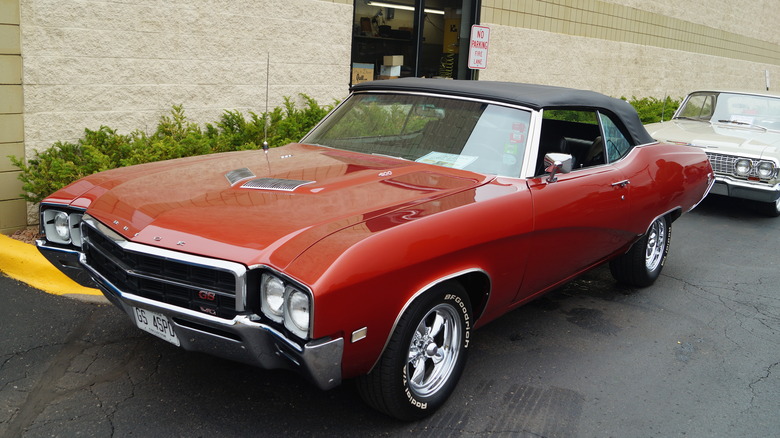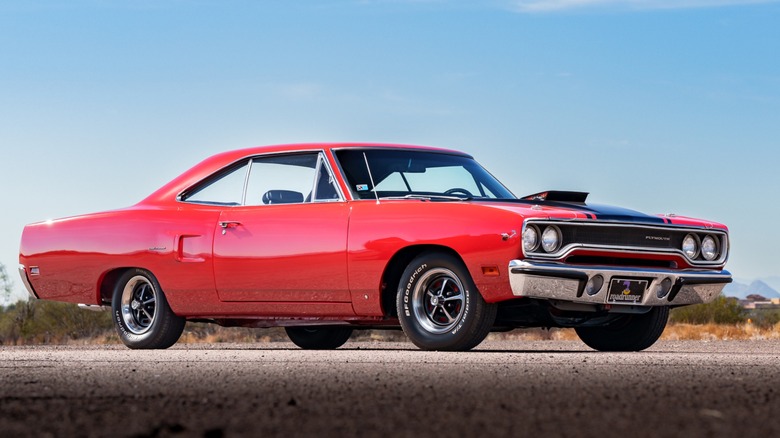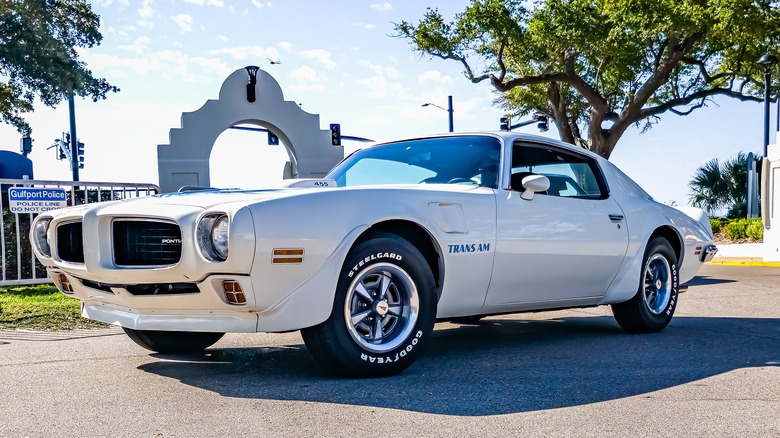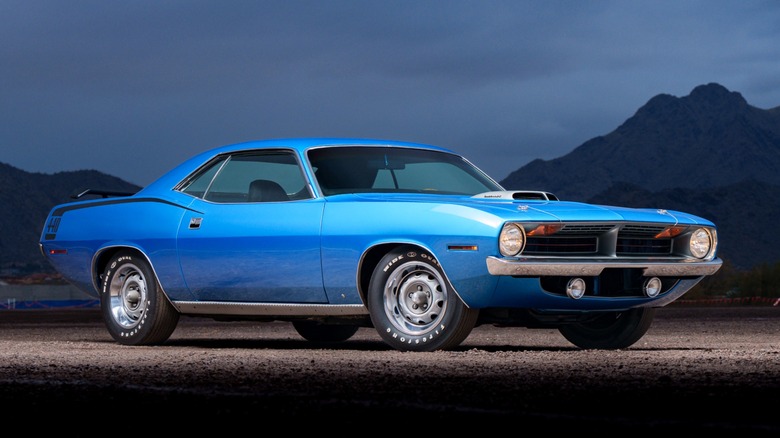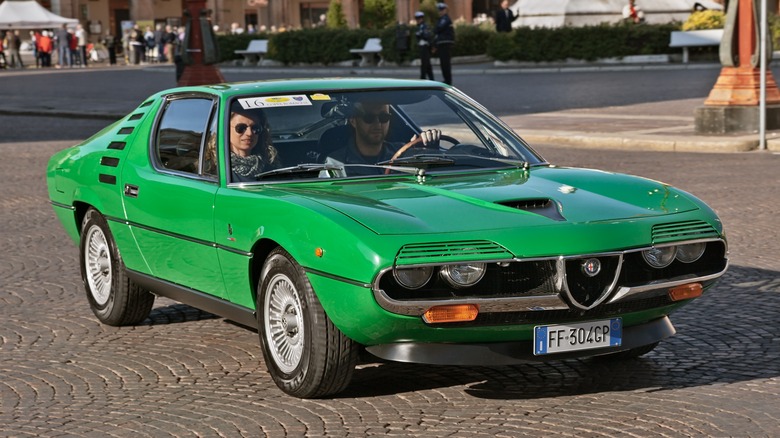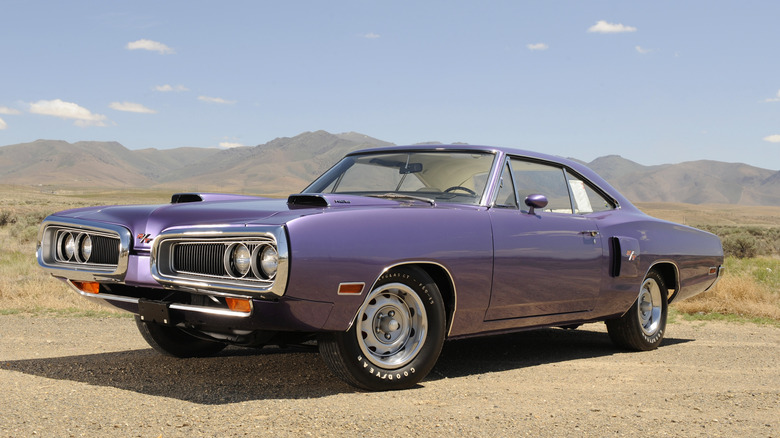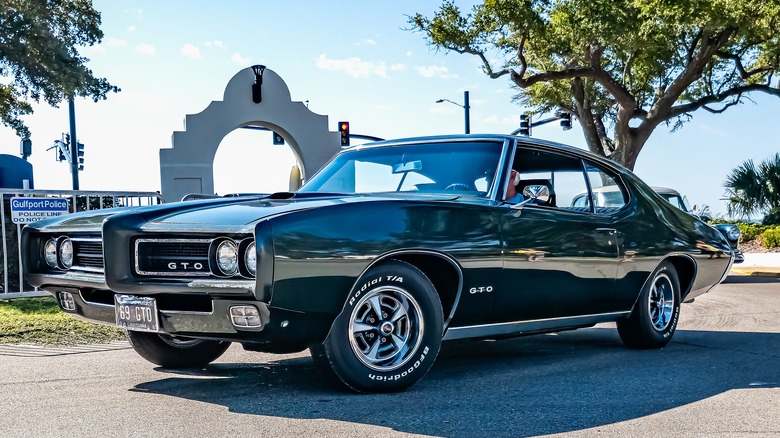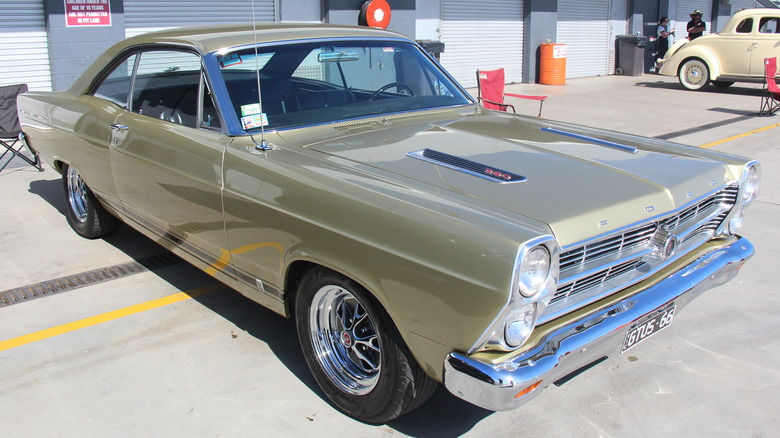11 Stylish Classic Cars With Hood Scoops
Classic cars aren't just called classic because they've aged; they are pieces of history with wheels, instantly recognizable due to their distinctive design, unmatched performance, and the popularity they generated during their run. However, if we go by the book, according to the Antique Automobile Club of America, a car must be 25 years old to be classified as an "antique," though "classic" is often used more broadly. In the U.K., HM Revenue and Customs defines a "Classic Car" as a model that is 15 years or older with a minimum value of £15,000 (around $20,200). Since the term doesn't have a single definition, many car lovers rely on personal criteria, such as era, design, or features like a hood scoop, when calling a car a classic.
Hood scoops have been a part of muscle cars and sports cars for years. They aren't just for cosmetic purposes, but also function as a fresh air inlet for the engine bay, which eventually helps generate more power. There are different types of hood scoops, namely: Shaker, Ram Air Intake, Cowl Induction, Intercooler, and Faux scoop. While pinpointing the first car with a hood scoop is debatable, early examples include the 1949 Ferrari 166 MM Barchetta and the 1949 Healey Silverstone. American models like the 1952 Mercury Monterey also featured early scoop-like designs. American or not, here is our list of some of the best classic cars with hood scoops.
1958-1963 Aston Martin DB4
If you are a 007 fan, you would associate an Aston Martin with James Bond. While the Aston Martin DB5 was ultimately the car chosen for James Bond's 1964 movie "Goldfinger," during its preliminary shoot, it was the Aston Martin DB4 that was James Bond's car. Interestingly, Sean Connery, as James Bond in "Goldfinger," drove the Aston Martin DB4, a classic car with the hood scoop, on the Bond set. But as soon as Aston Martin was ready to roll out the DB5, it replaced the DB4. So, technically, it was the DB4 that was the first Aston Martin to be used in a Bond film.
British carmaker Aston Martin started development of the DB4 model in 1956. It was a completely new vehicle featuring Carrozzeria Touring's "Superleggera" bodywork, which included a lightweight framework made of thin steel tubes covered with aluminum alloy panels. The new car was shown off at the London Motor Show in 1958, and at the time, it was Britain's most powerful and fastest production car, capable of reaching 0-100 mph in just 30 seconds, quick at that time.
It was fitted with a 3,670 cc DOHC straight-six engine that produced 240 bhp at 5,000 rpm. The car was produced from 1958 to 1963, but the 1961 version introduced noticeable changes, including the hood scoop on the bonnet, which was positioned much lower and without a grille. This hood scoop remained a part of the Aston Martin DB4 through the DB5 until the DB6 Mark II arrived in 1970.
1963-1967 Chevrolet Corvette Sting Ray C2 427
Speaking of some of the most popular cars, specifically muscle cars of the 1960s, the Chevrolet Corvette Sting Ray C2 stands out, with "C2" denoting the second generation of the model. The first Corvette Sting Ray came off the production line in 1963, while the Corvette model had existed since 1953. Designed by GM designer Bill Mitchell, the Sting Ray C2 featured a unique split-window design and had a frame inspired by the aquatic creature stingray. This design made it a collector's item, with the most expensive 1963 Corvette Sting Ray C2 selling for $1,242,500 at Gooding & Company's 2022 Amelia Island auction.
Fun fact: The split-window design lasted for just one year, and while the Z06 model offered it as optional, it was eliminated because, according to the Corvette Museum, it "intruded into the driver's rearward vision." During its five-year run from 1963 to 1967, a total of 117,964 C2 Corvettes were produced. The C2 received upgraded engines, starting with a 327-cubic-inch small block V8 in its initial years, then a 396-cubic-inch big block in 1965, and finally its largest engine, the 427-cubic-inch big block, in 1967. The 1965 model was one of America's first mass-production cars to feature disc brakes on all four wheels.
In 1969, a year after the arrival of the Corvette (C3), the moniker "Sting Ray" became a single word: "Stingray." The front brake air scoop present on the 1963 model was replaced with a large, stingray-inspired, aggressive-looking hood scoop in the 1967 model.
1970-72 Buick Gran Sport 455
Besides Ford and General Motors, the names that pop up in our minds when talking about the first carmakers in the U.S. and the world, Buick can also be put into the same category. Founded in 1899, Buick made history in 1906 by becoming the first and only car to complete a 1,000-mile relay race from Chicago to New York. It also became the first vehicle to travel across South America, achieving this feat in 1914. In 2024, Buick celebrated 120 years of its logo by introducing an upgraded tri-shield logo.
Buick became a success thanks to William Durant, the founder of General Motors, who turned it into America's highest-volume producer just four years after he took over as the general manager of Buick in 1904. This success led to the formation of General Motors in 1908, and Buick came under GM's wing. The company is known to have produced some classic muscle cars, along with sporty models such as the Reatta. In 1970, Buick produced the GS (Gran Sport) 455, which was also known as a gentleman's hot rod (via MotorTrend).
This luxurious muscle car was available in two variants: convertible and coupe, both offered with a single 455-cubic-inch "nailhead" V8 engine option. In its standard configuration, it produced 350 hp, and in Stage 1 trim, the output rose to 360 hp. The two air inlets were connected to a functional hood scoop, letting fresh, cool air into the carburetor and boosting the GS 455's performance.
1969-1970 Plymouth Road Runner Air Grabber
Remember Looney Tunes? Wile E. Coyote and Road Runner from the famous animated television series "The Road Runner." Well, that's the program that was on the minds of Chrysler carmakers when they decided to name the toned-down version of the Plymouth GTX –- meant for young riders –- the Plymouth Road Runner. Plymouth paid $50,000 to use the Road Runner name and likeness of the cartoon character, and spent another $10,000 for that iconic "beep beep" sound of the animated character.
The result of all this was the Plymouth Road Runner, which became not only an icon of U.S. muscle cars but also one of the best muscle cars from Plymouth. Apart from its interesting naming story, the Plymouth Road Runner was also popular for its "Air Grabber" functional hood scoop. The 1969 model of the Plymouth Road Runner Air Grabber was offered with a 383-cubic-inch V8 engine producing 335 hp. It was also available with two other engine options: a 426-cubic-inch HEMI and a 440-cubic-inch V8 with dual Holley carburetors.
At the front was the signature "Air Grabber" hood scoop, delivering the engine a stream of cool air. The Plymouth Road Runner was in production from 1968 to 1975, but the Air Grabber hood scoop was available as an optional feature only from 1969 to 1971. On Road Runners with the optional HEMI engine, the "Air Grabber" hood scoop came standard, while on other engines, it was known as the N96 option and was available for an extra $65.55.
1970 Pontiac Firebird Trans Am
The 1960s is regarded as the golden age for American car manufacturing, thanks to the rise in muscle cars and pony cars. The huge V8 engine clicked with the American people, and all they wanted were fast, durable, and aggressive cars. Muscle cars from Dodge, GM, Chevrolet, Ford, etc., were filling the gap in the industry with one offering after another in the '60s. GM's other brand, Pontiac, also came up with a bunch of iconic muscle cars. Pontiac initially wanted to release a sports car, but after GM's executives rejected the idea, the company finally came up with the Firebird Trans Am model.
The name Trans Am came from the Trans-American Cup racing competition held by the Sports Car Club of America (SCCA). For the name, Pontiac paid $5 per car as royalty. The first Firebird Trans Am was produced in 1969, and it enjoyed a 35+ year run until 2002. The first-generation Pontiac Firebird Trans Am was in production from 1967 to 1969 and sold around 250,000 units, with the last year producing only 697 units. However, the second-generation Firebird Trans Am, produced from 1970 to 1981, is considered the best version of this model.
The 1970 model kept the 400-cubic-inch Ram Air III engine from the 1969 model, which produced 345 hp. While it was also offered in an optional 370 hp Ram Air IV setting, only 88 out of the total 3,196 Trans Ams were equipped with that engine. These engines got fresh air from the new rear-facing shaker hood scoop.
1970 Plymouth Barracuda
Plymouth, a Chrysler brand, produced some of the best muscle cars during the '60s and '70s. There are a few models, such as the Barracuda, that deserve more love and attention, especially the 1970 model. The Plymouth Barracuda came to life in 1964 as a competitor to the popular pony car, the Ford Mustang. It was named by Chrysler designer John Samsen. The Barracuda had its base taken from the Plymouth Valiant. While it was offered in a range of engine options, from an inline-six to a V8, it didn't deliver the grunt people wanted at that time.
The third-generation Plymouth Barracuda, which arrived in the 1970s, was the one that put the 'Cuda on the muscle car map in America. It was completely redesigned, featured sharper lines, sat on an E-body platform, had a muscle car's aggressive look, and boasted grunt under the hood, exactly what people wanted. Fun fact: The fourth installment of the Keanu Reeves action movie series "John Wick" used a 1971 Plymouth Barracuda. The 1970 model was offered in three variants: the basic model with toned-down interiors, the Grand Coupe (a luxury version), and the Cuda sports version.
The 1970 Plymouth Barracuda classic car was available in multiple engine packages, including the Hemi 426 that produced 425 hp. Also, the car was available in what some might call wild color schemes. All variants were available with any of the three hood styles: a flat hood scoop, a Shaker hood scoop, and a Power Bulge hood scoop. The 'Cuda finally breathed its last in 1974, but left a lasting impact.
1972 Alfa Romeo Montreal
Every carmaker has a point in their history when they have to come up with something extravagant or weird. The Italian carmaker Alfa Romeo, with over a century of history behind it, launched the Alfa Romeo Montreal, a car unlike anything else in the company's portfolio. It was based on the company's Giulia Sprint GT, with Carrozzeria Bertone tasked with designing the bodywork, and the famous Marcello Gandini –- who styled the iconic Lamborghini Miura –- was chosen to design the Montreal. Two concept cars were then displayed at Expo 1967, a World's Fair hosted in Montreal, Quebec.
Both concept cars grabbed eyeballs, so much so that Alfa Romeo had to come up with a street-legal model, the Alfa Romeo Montreal. The market-ready car was shown off at the Geneva International Motor Show in March 1970 but became available for purchase two years later in 1972. The car was fitted with a 2.6-litre V8 engine, producing 200 hp. The design was highly tweaked, but the production model retained the headlight blinds shown in the concept vehicle.
It is one of the good examples of a faux scoop on a car, because the hood scoop on this Alfa Romeo wasn't functional. It was purely for cosmetic purposes. It also made its way to Hollywood and was featured in Charlize Theron's movie Atomic Blonde.
1970 Dodge HEMI Coronet R/T
One of the rarest HEMI-powered muscle cars, the Coronet R/T was based on the Coronet 500. The first-generation Coronet was produced in 1949 and enjoyed its run as a passenger car before being briefly retired in 1959. The Coronet name was later revived in 1965, and by 1966, it was available with big-block HEMI V8 engines that produced a staggering 425 hp. Interestingly, the first four generations of the Dodge Coronet lasted from 1949 to 1959, whereas the fifth generation ran from 1965 to 1970, and the sixth and final generation lasted through 1976.
The 1970 model Dodge Coronet was launched in the R/T version, which stands for Road/Track. True to its name, the Chrysler HEMI V8 engine pumped out 425 hp, making it the most powerful Coronet ever. The 1970 Coronet R/T came with the Chrysler B-body, the same platform as the Dodge Charger, Plymouth GTX, and Plymouth Road Runner. A duo of hood scoops and fender scoops was specific to the R/T model, and they were functional. Dodge also offered the option to fit a Ram Air Intake hood scoop. Only 2,319 units of the 1970 Dodge Coronet R/T were produced, and it was offered in unusual colors such as Plum Crazy, Sublime Lime, Go-Mango, Hemi Orange, and Banana Yellow.
1969 Pontiac GTO
According to Street Muscle Magazine, many people consider the Pontiac GTO to be the "original muscle car," and there's no denying that. The journey of the Pontiac GTO began in 1964, and the first model, the A-body LeMans GTO, was the only entry in the GTO lineup until 1966. But the 1969 Pontiac GTO stands tall among other variants, as it was the company's answer to reverse the decline in GTO sales. The refreshed design introduced in 1968 was carried over to the 1969 model, with changes appearing only in the grille, taillights, and some tweaks to the rear.
Interestingly, the 1969 GTO was available in two trims: standard and "The Judge." The latter was inspired by the popular "Here Come da Judge" comedy TV sketch, and choosing this trim would boost performance while also introducing some minor aesthetic changes. The standard model was available with a 400-cubic-inch (called Ram Air) engine producing 350 hp, and the 400-cubic-inch L74 V8 (Ram Air III) engine producing 366 hp.
The Judge trim was available with the standard L74 Ram Air III V8, as well as the new 400-cubic-inch L67 Ram Air IV, producing 370 hp, making it the most powerful GTO ever. The 1969 model came with a functional hood scoop with the Ram Air III and Ram Air IV engine options, keeping it far from our list of most hated Pontiac models ever.
Ferrari 550 Maranello
The center-mounted hood scoop on the Ferrari 550 Maranello provided the required fresh air intake to the front-engined V12 engine. Speaking of the engine, the car was equipped with a 5.5-liter unit that produced 478 ponies, with Jalopnik giving it the apt title of "the last truly great Ferrari." The aerodynamic design of the car helped it set a new production car speed record on October 12, 1998, in Marysville, Ohio, covering 100 km at an average speed of 304.1 km/h and 296.168 km/h over one hour.
The Maranello debuted at Nurburgring, Germany, in 1996. Famous F1 driver Michael Schumacher was one of the Ferrari team drivers to take the 550 Maranello for a spin on race tracks. In 1998, the British magazine Autocar also named it "Britain's Best Driver's Car 1998." The 550 Maranello shared various design elements with the 456 GT but also featured some retro hints.
Ferrari expert and CEO of Carrozzeria Primavera in Florence, Italy, Simone Beneforti, said that the front-engine 550 Maranello was a clear reference to the 275 GTB. A total of 3,083 units of the 550 Maranello were produced, and it enjoyed a production run from 1996 to 2001.
1964 Thunderbolt/1966 Ford Fairlane R-Code
In 1964, Ford showcased the Fairlane Thunderbolt, which was an experimental machine built exclusively for drag racing. It was so rare that only 100 units were produced for the 1964 model year, with 51 equipped with automatic transmissions and 49 with manuals. It featured lightweight Fairlane bodies fitted with dual-quad Galaxie motors. The result was a stripped-down Ford Fairlane Thunderbolt, which was not only 3 inches shorter but also weighed 700 pounds less than the Galaxie. It is also said to have unofficially produced a staggering 500 hp.
One of the few drivers who had the privilege of sitting in the driver's seat was Phil "Daddy Warbucks" Bonner, a famous racer in the late 1950s. The combination of Bonner and the Ford Fairlane Thunderbolt brought many victories to the Ford team, and he became a legend in the national drag racing community. The 1964 Ford Fairlane Thunderbolt featured a 7-liter FE V8 engine, which officially produced 425 hp. It had an iconic fiberglass hood scoop that fed cold, dense air to the dual Holley carburetors.
Speaking of the 1966 Ford Fairlane R-Code, it was a product of Ford's racing division, built as a street-legal vehicle with a V8 engine. It was equipped with a 6.4-liter engine and was available only in Wimbledon White with steel wheels. The dual Holley 570 CFM four-barrel carburetors received fresh air through the fiberglass hood scoop, often referred to as the "Thunderbolt-style" scoop. Interestingly, only 57 of these models were ever produced.
